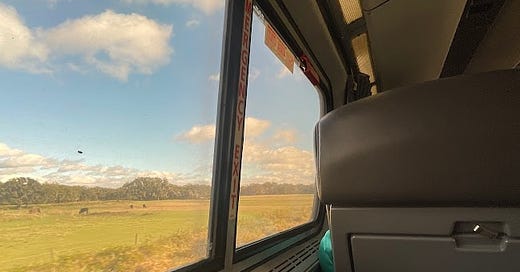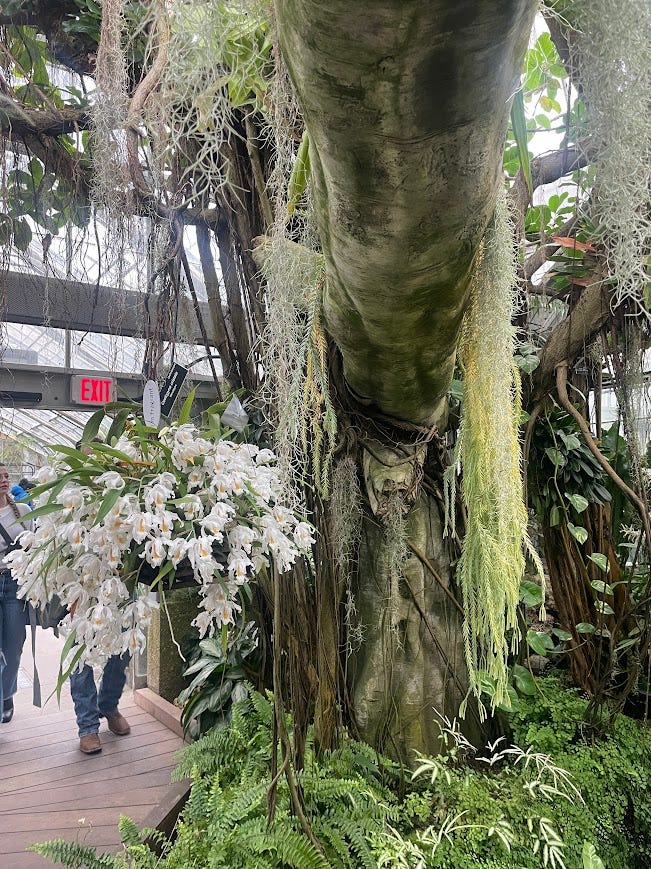On the Train, Off the Rails [Corrected with More Train Lore]
When the world you’ve returned to feels very different than the one you left
The previous version of this email left out two entire paragraphs I had written about Amtrak history. For train lovers, you’re welcome. For everyone else, sorry for the double email.
Hi from the Amtrak Floridian, somewhere south of Orlando!
This is the last and longest leg of my multi-stop Amtrak journey down from Rhode Island. While the other legs were 3-4 hour routes on the Northeast Corridor that I’ve taken before, this Raleigh-Fort Lauderdale leg is the real adventure. For those who play Ticket to Ride, I think I’ve more than earned my six-car line. Even after taking fast and functional trains in Europe and Asia, there’s something magical about taking the train in America, where it feels miraculous that it even still exists.
For fellow transit lovers, the Floridian is actually a temporary Amtrak route that opened in November 2024, departing once per day between Chicago and Miami. To accommodate maintenance work, it merges the Silver Meteor, which has served NYC - Miami since 1939, and the Capitol Limited, which normally runs between Chicago and D.C. The Floridian name was previously used in the 1970s for a train connecting Chicago and Florida that ran south through Indiana, Kentucky, Tennessee, etc. The closure of this line left Louisville and Nashville as two of the largest cities in the U.S. without any Amtrak service, which directly impacted my own trip as I took a flight detour to visit a friend in Nashville!
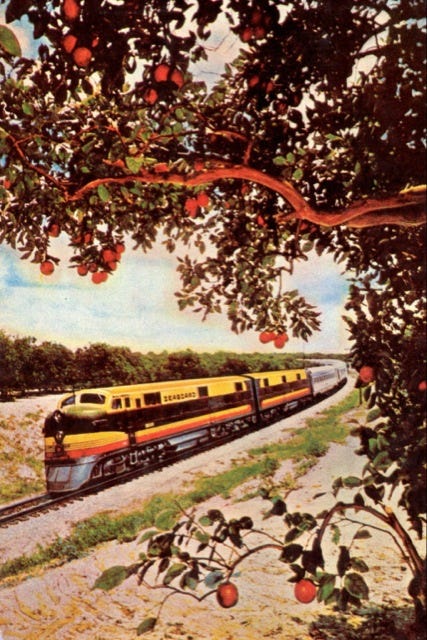
There was a time you could have travelled essentially the circumference of the country on Amtrak, but now there is a missing piece between Jacksonville and New Orleans.

Some press releases say the line was closed after Hurricane Katrina, but others say it closed in 1996 due to funding troubles. From what I’ve been able to piece together, two lines are getting conflated. The Gulf Coast Limited from New Orleans - Mobile opened in 1984, in part because of the Louisiana World Expedition. It discontinued in 1985 after Mississippi pulled its support, but re-opened for a trial run in 1996-1997 after the Gulf Breeze from NYC - Mobile was discontinued. Despite high ridership during the trial period, the states did not provide funding for a permanent service. The other train that once served New Orleans - Florida was the Sunset Limited, much of which still exists and is the oldest continually operating train in the U.S. — serving passengers in some form since 1894! Originally a California - New Orleans route, it was extended to Florida in 1993 on the former Gulf Wind route, which had served New Orleans-Jacksonville from 1949 to 1971. The New Orleans-Jacksonville segment of the Sunset Limited is the one that was discontinued after Hurricane Katrina. While damaged track was repaired relatively quickly, the hurricane provided a reason to suspend a sparsely populated route with operational challenges.
However, with community and bipartisan political support, the section between Mobile and New Orleans is scheduled to re-open sometime this year, but has faced delays. Hopefully this summer! There is even discussion about extending from Mobile down to Orlando and Miami. These tracks already exist, but one of Amtrak’s primary challenges is securing the rights and funding to operate on lines now owned by private freight operators like CSX. It’s also one of the reasons Amtrak is often so slow and delayed! Freight companies often ignore Amtrak’s legal right to preference on the rails, leading to 15,000 hours of delays in 2023.
Gulf Coast route notwithstanding, Florida has an impressive amount of rail for such a car-centric state. This includes almost 20 Amtrak stations, the high-speed Brightline between Miami and Orlando, 80 miles of commuter rail (Tri-Rail) between Miami and West Palm Beach, and 60 miles of commuter rail (SunRail) in the Orlando region. It’s easy to think but people in Florida don’t use transit! But in 2023, Tri-Rail had more annual riders than MARC, which serves the Baltimore/D.C. region. For its part, Amtrak had an all-time ridership record in 2024 — long live the train!
I was shocked to discover my Amtrak train to be mostly full despite its slow pace – it is taking 22+ hours to go between Raleigh and Fort Lauderdale! Currently, the route does not branch off for the West Florida trains, so we are rolling west into Tampa and then turning back east to get down to Miami. I’ve spent a lot of the ride trying to figure out why all the other passengers are here. After all, I’ve taken Spirit flights as cheap as $19, and, on average, Florida has some of the cheapest airports to fly into/out of in the country (especially Fort Lauderdale and Orlando). Assuming that most people here aren’t just train fans with a lot of time on their hands like me, I’m pleased to realize there must be people for whom this is the most desirable option.
First of all, this section of Amtrak is quite cheap. It was about $60 to get here from Raleigh, and people traveling from, say, Jacksonville to Tampa, are paying about $20. A Florida man (and yes, based on my eavesdropping, he was a true “Florida man”) traveling from Jacksonville to Tampa said that he would have needed a layover in Orlando or Miami that would have made the trip just as long, and much more expensive. And of course, not everyone is willing to deal with the discomfort of flying budget. The train’s seats are pretty spacious, and there’s even a leg rest as part of the recliner.
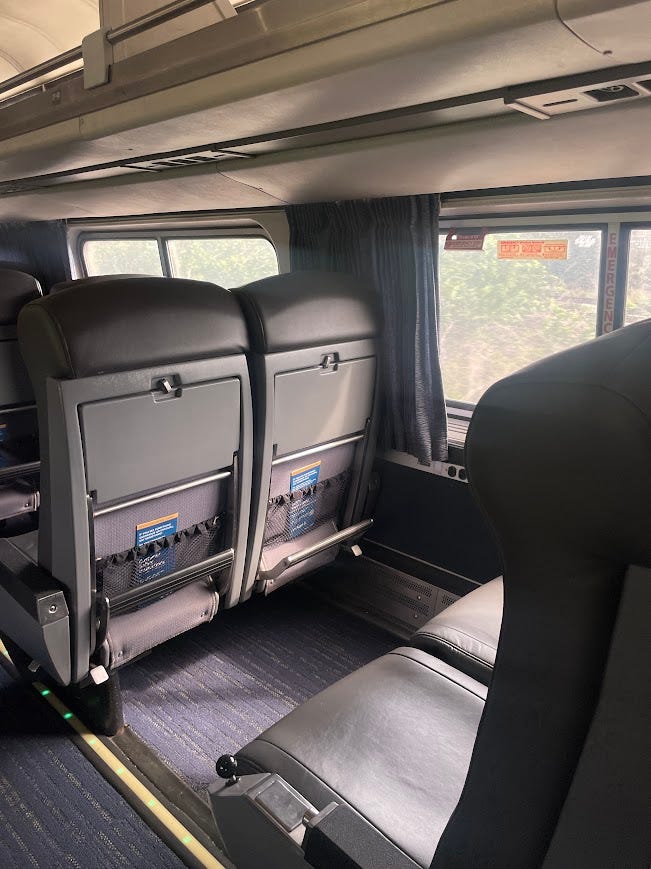
You can bring a decent amount of luggage at no additional cost, and there are even sleeper cars with private bathrooms and showers (though these cost a few hundred dollars). There’s not anything on a plane quite like a cafe car to get a nice break from your seat.
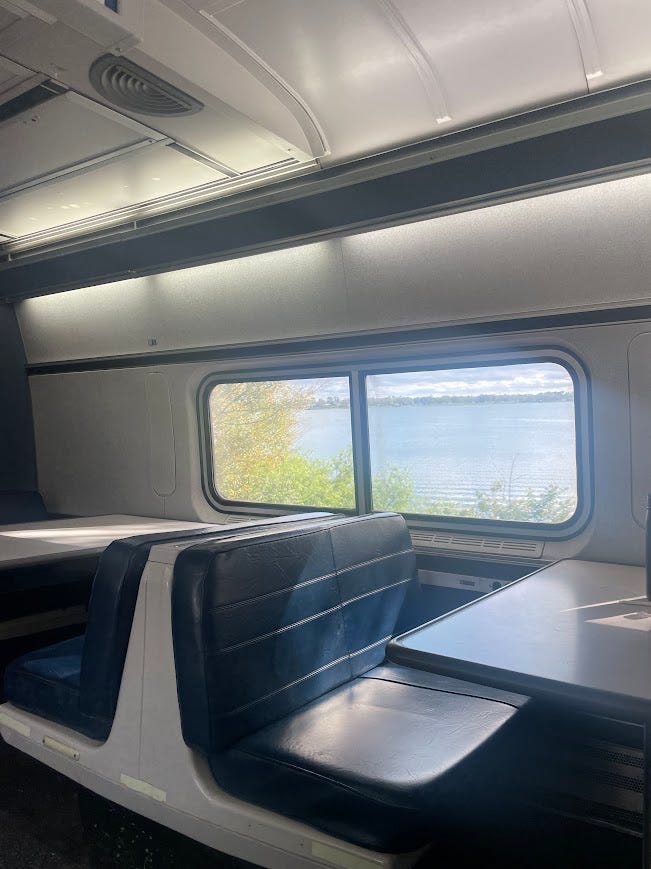
The train stops in a lot of smaller places that would require driving from an airport. Many of these train stations are along cute, little main streets that probably originally existed thanks to the railroad. Since this train only runs once a day, many of these stops happen overnight, or I might have indulged in a daylong layover in Savannah. There were a few large families boarding at the same time as me, and I can see how the train offers a little more space and options to step out for air. Overall, I’m leaving encouraged that there already is much more demand for rail in America outside the Northeast than I realized, and there could be even more if we make these systems even more convenient, comfortable, and affordable.
Post-Sabbatical Disorientation
I would transition by saying that’s enough about trains, but you could never talk to me enough about trains! But there’s more I want to cover in this post. While I knew I wanted to continue writing Recess for at least a few months after our return to the U.S., I’ve struggled more than I expected to figure out how to write about my adjustment back. Typically each of these posts summarizes the latest chapter of our travels, and this chapter has felt hard to define! While I’ve been visiting friends and family, I don’t have a clear narrative about what I’m doing or for how long. When friends of friends or my train seatmates ask me where I live, I pause and say that I guess I don’t really live anywhere right now, but I’ve just returned from a year living abroad. It’s good practice to start my elevator pitch for “so where did you move here from?,” but it has also touched on larger uncertainties.
Before returning to the U.S., we quipped that we were coming back at the worst time, it being one week before the inauguration. While we expected it to be bad, the new administration has been much more disruptive, much more quickly than we previously thought possible. In the grand scheme of things, my personal life is far from being the most directly or harmfully impacted. However, I set out to document the personal journey of returning from a sabbatical, and the current state of affairs (to put it politely) has had no small impact.
About three months ago, we made the decision to end our travels in January. I wrote about feeling a profound sense of peace, that I had achieved what I set out to by taking a sabbatical and felt open to whatever the next step looked like. I had worked on building self-confidence rooted not in having a successful job or being on the right path, but on my ability to adapt and be happy in a wide variety of situations. I predicted these revelations would not just vanish when my exciting travels came to a close, and for the most part that has been true. I have shifted my perspective in ways that cannot be undone so easily. But one or two days a week, I am forced to confront the horrors we are living in and how they affect my current situation.
While my sense of equanimity is not completely shot, I have returned to a country and a set of possibilities that feels very different than when I left. Chris and I both felt satisfied with this period of exploration (for now), and were eager to seek some stability. When I imagined adapting, it was within a set of circumstances I understood to be true: that my field (government/planning/social equity) gave me some job flexibility and security, and that my years of service in federal government meant I had some hiring preference should I choose to return. When I started my job search in November, I felt like I was getting ahead of it. By the time I returned to the U.S., I would have gotten the ball rolling on screenings and interviews. I could enjoy the last bits of my time off, rest assured that I would walk back into my industry with a few months of solid effort. While I worried about the impact of having taken time off and the job market’s so-called “Great Stay,” I reminded myself of my years of experience and the relative stability of my industry.
Of course, the scale of change to government employees and funding in the past five weeks has been unprecedented and horrifying. My heart aches for my friends and former colleagues in government who are trying to navigate this cruel chaos. My industry feels like it’s being gutted. Even if local governments, non-profits, academia, and private planning firms had enough vacant positions to ingest thousands of fired federal workers (they don’t), most of these organizations will be directly impacted by federal funding freezes, cuts, and limitations. To continue to receive federal funding, they may have to eliminate DEI-related language and activities, as specific (and ridiculous) as not being allowed to use the word “woman.” Even if I manage to land a job in the field during this time (which I have to believe I will, or continuing to write these cover letters is the definition of insanity), my job security will be much more precarious should these organizations face further challenges. In short, it’s pretty much the worst time in my working life to be returning from a sabbatical.
I share all of this not to complain, but to explore the ways I am being pushed to further stretch my own willingness and confidence to adapt. In a popular piece published after the election, “How I became ‘collapse aware,'” Rosie Spinks confronts coping with the understanding that “something about the way we live is coming to an end,” a change that no single election or economic turn will bring us back from. She observes that many millennials have experienced their entire adulthood under the creeping feeling that the American narrative of infinite progress isn’t going to last. I see this in the way my friends have had to consider moving based on avoiding fires and floods. I see it in the decline of “stable” jobs and college graduates not being able to get entry level work. I feel it as I follow the conventional wisdom to plan my future retirement around the reliable long-term growth of the market, even while climate scientists project the world and its economy will look very different by the time I can retire. In the face of weakened social safety nets and increasing uncertainty, even those of us who live with relative privilege and access to resources feel a sense of unpredictability and less room for error.
As I’ve already stated, I am far from one of the people most drastically affected by our overlapping crises. However, returning from a sabbatical at this particular moment has forced me to move from what Spinks describes as the “There” (the state where we keep on living as normal, because sometimes what else can we do) to the “Here” (the state in which we are forced to adjust our lives to a new and rapidly evolving normal). I cannot just stay busy and not face it, because my main project right now is finding a new job and place to live amidst that suddenly being more difficult. While I’m grateful to have a constellation of “home bases” with family and friends, I am not currently rooted in a community where I am well-connected to organizations and neighbors (notably, one of the most commonly cited factors in resilience to and recovery from crises). I’m seeking to re-establish my own “normal” while my understanding of what that can look like is shifting.
When I left for my sabbatical, I willingly stepped off a path that I believed would still be there. Now, I am grateful for the lessons I learned from my sabbatical because I understand it might not. I’m grateful to have explored alternative ways to approach my life, because they may be quite useful if my short- or long-term plans change for reasons outside of my control. As I muse about contigency plans and stretch my adaptability in this in-between period, these are a few of the ways I’m grounding myself:
Paying attention to my surroundings: I wrote earlier this year about working through some of my climate anxiety through local action while staying in an off-grid cabin. Another balm that has really stuck with me from my time away is taking moments to pay attention to where I am, specifically to simple joys in nature. In my recent reading of Jenny Odell’s How to Do Nothing: Resisting the Attention Economy, I was surprised to find just how much she writes about her birdwatching hobby in a book largely about the Internet. She explains how what grabs our attention online often lacks context — not just factually or historically, but spatially and temporally. Discussing her relationship to the natural and human environment in the Bay Area, she offers, “given that all of the issues that face us demand an understanding of complexity, interrelationship, and nuance, the ability to seek and understand context is nothing less than a survival skill.” Recently, this has looked like taking a moment to listen to the city birds on a bike ride in Durham, or pausing with other runners to watch a bird catch its prey in Brooklyn’s Prospect Park. When I feel fear about the future of our climate, I try to be present to and aware of what is here now.
Engaging in civil society, however small: I recently finished the short book “On Tyranny” by Timothy Snyder, which I referenced briefly in my post about living in South Korea during the attempted coup. He outlines twenty lessons from the twentieth century for ordinary people facing fascism. I was especially influenced by chapter 15, which focuses on involvement in civil society, whether it be expressly political or just a social activity. He writes “Insofar as we take pride in these activities, and come to know others who do so as well, we are creating civil society. Sharing in an undertaking teaches us that we can trust people beyond a narrow circle of friends and families, and helps us to recognize authorities from whom we can learn. The capacity for trust and learning can make life seem less chaotic and mysterious, and democratic politics more plausible and attractive.” Recently, this has looked like reconnecting with old teachers and coaches in Richmond, and participating in Black History Month events in Durham.
Rebuilding my sense of spirituality: Spirituality has been an important grounding force in my life as long as I can remember. Odell, discussing the ideas of monk and activist Thomas Merton, adds “removal and contemplation were necessary to be able to see what was happening, but that same contemplation would always bring one back around to their responsibility to and in the world.” In recent years, I have been trying to find new ways to engage with spirituality and seek wisdom from others after being in a controlling religious environment in college. In Denver, this looked like having a spiritual community that is much older than me. I have also been spending less time reading short takes from people online — even those who share my values — and more time reading books and newsletters, and discussing them with others. I am also trying to calm the anxiety in my body through meditation and prayer.
I am thinking of everyone who cares deeply about the world and other people, in all the ways the past five weeks have disrupted you or the people and organizations you care about. In times of overwhelm, I come back to one of my favorite books, Rebecca Solnit’s A Paradise Built in Hell. Exploring several major 20th-century disasters, she interviews survivors and is struck by how often they describe their experience as full of incredible connection, meaning, solidarity, and even joy. She writes, “... the point is not to welcome disasters. [But] disasters provide an extraordinary window into social desire and possibility, and what manifests there matters elsewhere, in ordinary times and in other extraordinary times … These flashes give us … a glimpse of who else we ourselves may be and what else our society could become.”
Speaking of sociologist and veteran Charles Fritz, she adds “[his] first radical premise is that everyday life is already a disaster of sorts, one from which actual disaster liberates us. He points out that people suffer and die daily, though in ordinary times, they do so privately, separately … ‘The widespread sharing of danger, loss, and deprivation produces an intimate, primarily group solidarity … People are thus able to perceive, with a clarity never before possible, a set of underlying basic values to which all people subscribe. They realize that collective action is necessary for these values to be maintained and that individual and group goals are inextricably merged.’”
In the past few years, and especially the past five weeks, the disaster of the everyday has felt especially present. This can sometimes make it feel easy to turn inward, to focus on the stress of my own job search, figuring out my own path. And as Odell, Merton, and others have written, there is a time for silencing the noise and looking within. But Solnit reminds me of the invitation of times of disaster and collapse to turn outward, towards collective resilience and support rather than individual successes or pain. In a way that now feels silly, I once daydreamed about returning from my sabbatical with the huge flex of having no issues immediately returning to my field. I wanted to prove that I was smart and savvy enough to both reject the traditional path and still thrive within it. Instead, I’m pushing myself to do what I have always strived to in this newsletter — to honestly share my experiences, both successes and failures, in hopes that others may see themselves in it and find some encouragement. Thank you as always for reading, and I’ll keep writing as I figure out my next steps.

